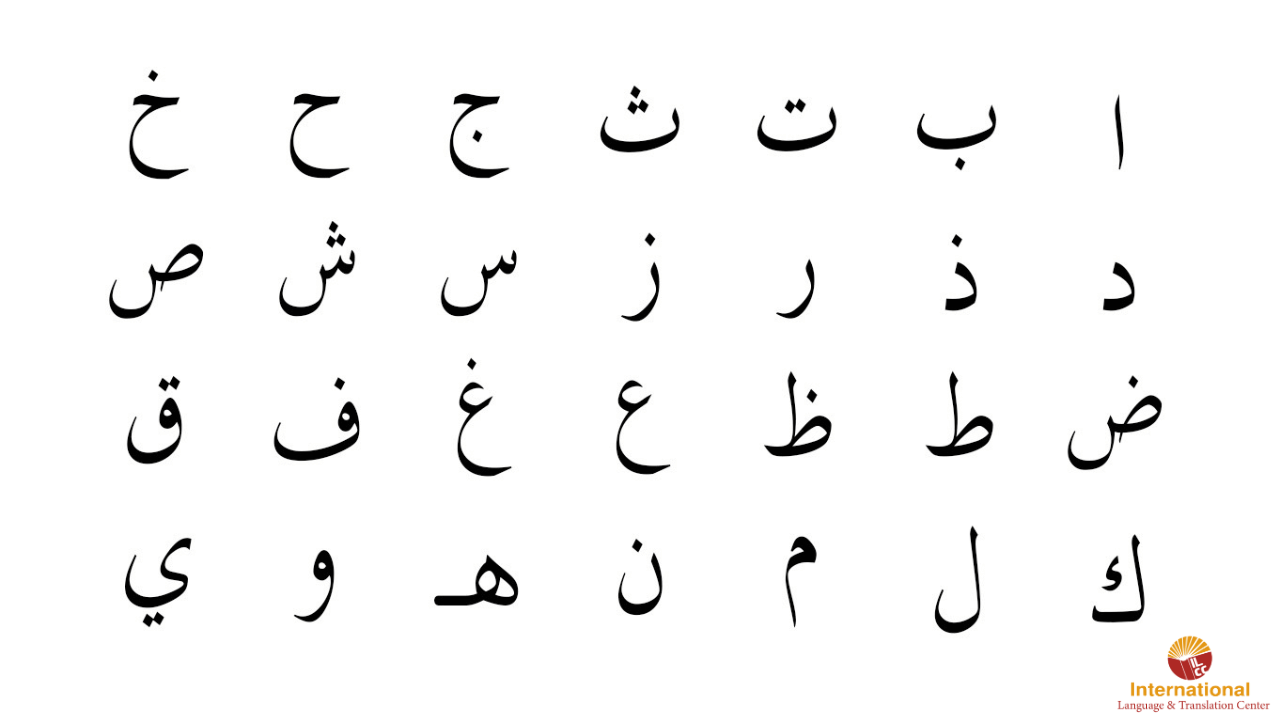learn arabic alphabet
You can learn arabic alphabet with ease after reading this article and getting a general idea about the Arabic language and the importance of the letters of the alphabet. In a world full of words and sounds, the Arabic alphabet serves as the foundation upon which the bridge of communication and understanding between people is built. Since ancient times, letters have represented the gateway of the human mind to a world of knowledge and culture. With the advancement of time and technology, understanding and using the basic letters of the Arabic language remains essential for anyone seeking to communicate and comprehend within the Arab society.
Understanding the Arabic alphabet is not just a skill but a fundamental foundation that individuals must acquire in their journey of learning the Arabic language. These letters represent an entryway to a vast world of reading and writing, serving as the first step in the linguistic exploration journey. Through understanding the letters, the learner can form words, then sentences, and consequently communicate and express confidently.
Learning the Arabic alphabet also represents a window to a deep understanding of Arab culture and its rich history. It is not merely a set of symbols but an integral part of a heritage dating back thousands of years, forming the essence of Arab identity. By learning these letters, individuals can experience a unique cultural journey and effectively interact with various aspects of Arab life, whether in literature, poetry, religion, or art.
Furthermore, the skill of understanding the Arabic alphabet is essential for personal and professional development. By continuing to develop this skill, individuals can achieve success in various areas of life, whether in work, education, or even daily communication.
Therefore, learning the Arabic alphabet is not just a routine exercise but an investment in a wealth of opportunities and experiences awaiting individuals in a world full of possibilities and challenges.
The importance of learning Arabic letters
Learning Arabic letters holds significant importance due to their foundational role in mastering the Arabic language. These letters are not merely symbols; they represent the essence of communication and expression in Arabic. Understanding them is the first step towards unlocking the richness of this language.
Arabic letters serve as the cornerstone of effective communication. Without a grasp of these fundamental units, individuals struggle to read, write, and comprehend Arabic texts. Mastery of the alphabet is essential for navigating through Arabic literature, engaging in meaningful conversations, and expressing ideas accurately.
Moreover, Arabic letters are more than just linguistic elements; they carry deep cultural significance. Each letter has historical roots and cultural connotations, reflecting the heritage and traditions of Arabic-speaking communities. Learning these letters allows individuals to delve into the cultural nuances embedded within the language, fostering a deeper appreciation for Arab culture and identity.
Furthermore, proficiency in Arabic letters enhances literacy skills. By mastering the alphabet, individuals develop reading fluency, comprehension, and writing proficiency. These skills are invaluable for academic success, professional growth, and personal enrichment.
Additionally, Arabic letters facilitate access to a vast array of resources in Arabic. From literature and media to educational materials and online content, knowledge of the alphabet opens doors to diverse sources of information and perspectives. It enables individuals to engage with Arabic culture, history, and current affairs on a deeper level.
In essence, learning Arabic letters is not merely a linguistic endeavor; it is a gateway to language proficiency, cultural understanding, and effective communication within Arabic-speaking communities. It lays the foundation for a lifelong journey of exploration, learning, and connection in the Arabic-speaking world.
Why do some people find it difficult to learn Arabic letters?
Learning Arabic letters can be challenging for some individuals due to several factors. Firstly, the Arabic script is different from many other writing systems, particularly those that use the Latin alphabet. This unfamiliarity can make it harder for learners to grasp the shapes and forms of Arabic letters, leading to initial difficulty in recognizing and reproducing them accurately.
Secondly, Arabic letters often have multiple forms depending on their position within a word. For example, a letter may appear differently at the beginning, middle, or end of a word, which can be confusing for learners who are accustomed to static letter forms in other languages.
Another challenge is the presence of similar-looking letters in Arabic, known as “homographs.” These letters share similar shapes but represent different sounds. For example, the letters “ب” (ba), “ت” (ta), and “ث” (tha) may look alike to beginners, making it difficult to distinguish between them without sufficient practice and exposure.
Furthermore, Arabic is a cursive script, meaning that letters are often connected in writing. This connectedness can pose a challenge for learners who are used to writing individual letters separately. It requires additional effort to master the fluidity of Arabic handwriting and ensure proper letter connections.
Additionally, the Arabic language has its own phonological system, with sounds that may be unfamiliar to speakers of other languages. Learning to associate these sounds with specific letters can be challenging, especially for learners who are not accustomed to the phonetics of Arabic.
Lastly, like any language learning process, mastering Arabic letters requires time, practice, and patience. Some learners may find it difficult to commit the shapes and sounds of Arabic letters to memory, particularly if they do not have regular exposure to the language or opportunities for practice.
Despite these challenges, with dedication, persistence, and the use of effective learning strategies, individuals can overcome difficulties in learning Arabic letters and achieve proficiency in the language.
Diverse Methods and Resources for Learning Arabic Letters
There are several diverse ways and means to learn Arabic letters effectively:
- Repetition and Practice: Regularly writing and repeating Arabic letters is crucial for memorization and mastery. Consistent practice helps reinforce recognition and recall of letter shapes and sounds.
- Educational Apps and Online Resources: There are numerous educational apps and online resources available that offer interactive lessons, games, and exercises specifically designed for learning Arabic letters. These resources often provide visual aids, audio pronunciations, and quizzes to enhance learning.
- Flashcards and Memory Aids: Creating or using flashcards with Arabic letters and their corresponding sounds can be an effective way to memorize and reinforce letter recognition. Memory aids such as mnemonic devices or visual associations can also aid in retention.
- Writing Workbooks and Worksheets: Utilizing Arabic writing workbooks and worksheets that provide structured exercises for practicing letter formation and recognition can be beneficial. These materials often offer guided instruction and ample space for writing practice.
- Language Classes and Tutors: Enrolling in Arabic language classes or working with a tutor who specializes in teaching Arabic can provide structured guidance and personalized instruction tailored to individual learning needs. Instructors can offer feedback, answer questions, and provide additional resources to support learning.
- Children’s Books and Educational Materials: Children’s books, storybooks, and educational materials designed for Arabic learners often feature colorful illustrations and engaging content that incorporates Arabic letters. These resources are particularly useful for beginners and younger learners.
- Language Exchange and Conversation Groups: Participating in language exchange programs or conversation groups with native Arabic speakers can provide opportunities to practice reading, writing, and pronouncing Arabic letters in a supportive and interactive environment.
- Multimedia Resources: Watching Arabic-language videos, listening to Arabic songs and podcasts, and engaging with Arabic-language media can help reinforce letter recognition and pronunciation while exposing learners to authentic spoken Arabic.
- Creative Learning Techniques: Incorporating creative learning techniques such as storytelling, role-playing, and mnemonics can make learning Arabic letters more engaging and memorable.
- Consistent and Persistent Effort: Ultimately, consistent effort, dedication, and persistence are key to mastering Arabic letters. Setting achievable goals, establishing a regular study routine, and staying motivated are essential for successful learning.
ILCC
Discover the world of languages and translation with us!
Join us and explore the world of languages and translation with the highest quality and professionalism! On our website, we offer you a unique and distinctive learning experience that allows you to acquire new language skills with ease and enjoyment.
Our center is distinguished by a team of qualified and specialized language teachers who ensure that they provide personal and effective lessons that perfectly meet your needs. Whether you want to learn a new language or improve your current level, we are here to help you achieve your goals smoothly and effectively.
In addition, our website provides accurate and professional translation services, where our team works to provide high-quality and reliable translations in various fields. Whether you need to translate official documents, marketing content, or scientific articles, you can rely on us to provide translation services with the highest standards of quality and accuracy.
On our website, we combine comprehensive language education and distinguished translation services to provide you with a unique and distinctive learning experience. Join us now and start your journey in the world of languages and translation with confidence and determination.
You can contact us on WhatsApp from here → ILCC.
conclusion
In conclusion, embarking on the journey of learning the Arabic alphabet is a pivotal step towards unlocking the richness of the Arabic language and culture. The Arabic alphabet serves as the cornerstone of effective communication, literacy, and cultural understanding within Arabic-speaking communities. Through dedicated effort, persistence, and the utilization of diverse learning methods such as repetition, educational resources, language classes, and multimedia materials, individuals can overcome the challenges of mastering Arabic letters and embark on a fulfilling linguistic adventure.
By embracing the intricacies of Arabic script, learners not only acquire essential language skills but also gain insights into the rich cultural heritage embedded within the Arabic language. Each letter becomes a gateway to a world of literature, art, history, and tradition, offering endless opportunities for exploration and discovery.
As learners navigate through the curves and lines of Arabic letters, they not only expand their linguistic capabilities but also foster connections with Arabic-speaking communities worldwide. Through the shared experience of learning and communicating in Arabic, individuals forge bonds, bridge cultural divides, and enrich their lives in countless ways.
Ultimately, learning the Arabic alphabet is not merely an educational pursuit; it is a transformative journey that opens doors to new perspectives, experiences, and connections. It is a testament to the power of language to transcend borders, unite diverse cultures, and celebrate the beauty of human expression. So, let us embark on this journey with curiosity, determination, and an open heart, as we unravel the mysteries of the Arabic alphabet and embrace the boundless possibilities that lie ahead.









